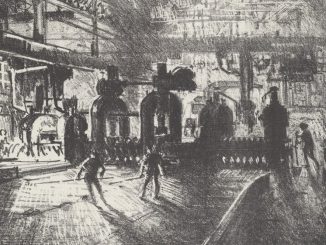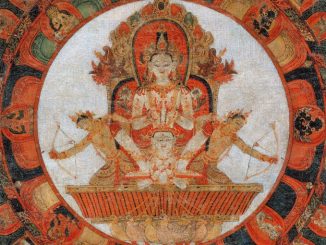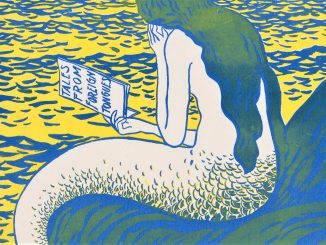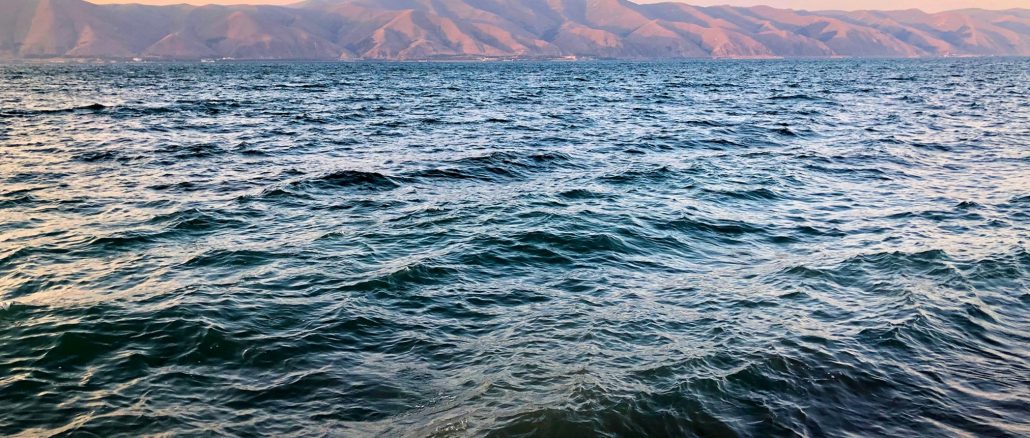
The pakhlava my medzmama made was formed from strands of DNA. It was ancestral wisdom, dipped in syrup; flaky, delicate phyllo dough perfected by thousands of medzmamas dating back to the days of Noah’s Ark. I wouldn’t be surprised if Noah’s own medzmama made it for him when they landed on Mt. Ararat, safe.
(Noah’s grandmother was not on the Ark and there was no pakhlava. This is diasporan memory where the facts have been lost. My mother’s family either 1. Chose to forget the past 2. Chose to tell me little about it for their own reasons 3. Made no choice and just proceeded unconsciously. Either way, mythology is what I’ve got.)
My medzmama made pakhlava at Christmastime. I was too young to know what had been lain before me, too ignorant to understand the marvel of such a treasure surviving our own family flood—carrying us from the Armenian villages of the Ottoman Empire to Jerusalem then Jaffa to Beirut then New York City before landing us—not on a mountain, but on Berendo Street in an East Hollywood neighborhood of Los Angeles, California. For most of my life, I wasn’t all that interested in learning either.
Now, decades later, my medzmama gone, I wonder: Did she carry the recipe on the ship along with her sorrows and her suitcase?
Here’s a fact: In 1954, my medzmama, her husband and four kids boarded an Italian luxury liner called―get this―the Cristoforo Columbo on route from Genoa, Italy to Manhattan. They were tucked into the hold, one of three refugee families―among the last let into the United States under a United Nations “special quota” of “displaced persons” resulting from the 1948 Arab-Israeli war. They were Palestinian refugees―except they aren’t Palestinian, they are Armenian; caught in the crossfire. This wasn’t their first go-round. Before my mother’s family were refugees, they were already stateless.
My medzmama, Hermine Kurkjian, was born in 1920 to Hagop Kurkjian and Yevgine Tombalakian in Aintab, an ancient city built into the limestone hills of the Caucasus between the Black Sea and the Mediterranean, near a tributary of the Euphrates River. The Kurkjian family had been in Aintab for who knows how many generations, perhaps since even before the Ottoman Empire captured the city in 1516. Now it’s called Gaziantep. It is in the Southeastern region of Turkey, not far from the Syrian border―known more for ISIS bombings than its long history. One of the few things I ever heard my medzmama say about the city of her birth was spoken in her rhythmic, monosyllabic English:
When I was 40 days old, we got out!
By 1920, the Ottomans had lost the war; the Allied Powers had won. The French who, at the time, were occupying Aintab said: Come on back to Aintab you Armenians who, driven out of your ancestral home and sent on death marches along with hundreds of thousands of others throughout the crumbling empire, miraculously survived ! It’s all fine now! The pull of home must have been strong, their desire to believe an intoxicating brew they couldn’t resist drinking. They went back.
The Siege of Aintab―a fight for control of the city―occurred in April, the very month my medzmama was born. France lost, Turkey won. The Kurkjians got out. That or die, I guess.
The family fled to the Armenian Quarter of the Old City of Jerusalem, which had been home to Armenians since the 4th century. They were one of thousands of families that, having survived mass deportations and slaughter by the Ottoman government, poured in when Jerusalem came under British Mandate.
I was probably sixteen years old that Sunday during the summer of 1987 when, bored, I went rummaging through an end-table drawer in the dining room of my medzmama’s Berendo St. house and came across a black-and-white photo of three young women in a park. They wore hats, gloves and heels, and stood stiff and formal among the trees.
Medzmama, I called out to her in the living room. Look at this old photo of you with your friends.
You’re all dressed up, I said, handing it over while sitting down next to her on her puffy 80s couch. She held the small, square photo up to her face, her eyes peering down through the bottom part of the lenses of her big round Sally Jesse Raphael eyeglass frames. After a pause, her eyes lit up with remembering.
We were in the garden of Gethsemane on a picnic, she said, nodding, stating it as a fact, no fanfare, as she passed the photo back to me.
It was a rare moment: seeing her sitting down, not on her feet, not in her kitchen. We were in her high-ceilinged living room, bright with Southern California light coming in from the large street-facing picture window. The color of her hair—a too-light shade of Clairol brown—clashed with the peach-colored couch cushions, which clashed with all the other furniture in the room. Nothing belonged together. There was a skinny metal mid-century modern lamp with cone-covered bulbs sticking out, a green brocade armchair with grayed doilies on the armrests, a wood buffet table, a black lacquer coffee table, a grand piano―and two brand new enormous puffy peach-colored couches.
That year, I was deep in rehearsal for my high school’s production of Jesus Christ Superstar. I was playing leper #3 in the leper scene and dancer #4 in the Christ-Lashing number, even though I was capable of so much more. That is what it was like to be a dark-haired, bushy-eyebrowed, overweight girl with cystic acne and a weird last name at the coastal public high school I attended in a wealthy area of Los Angeles. This turned out to be a theme, even after I lost weight and my skin cleared. I became an actor and even into my thirties, whether in theatre, TV or film, I never quite fit the parts available.
Point is, despite my unnamed roles I was taking my investment in the world of the play seriously and had been reading up on the bible, so I was pretty impressed: The Garden of Gethsemane―that’s where Jesus was betrayed by Judas. My grandmother picnicked there!
My medzmama looked over at me as I examined the photo, noting my baggy dark clothes, the overall moroseness of my teenaged being and must have sensed an opening. Trying to make eye contact, she asked: What’s the matter? Why you don’t talk anymore?
How to even begin? How could I tell her that it didn’t matter what I did, who I loved, what I wanted, nothing was going right for me and I knew, knew deeply, that it never would?
I looked up just briefly, smiled wearily, shrugged. She patted my knee, got up and headed back into her kitchen.
The Berendo St. house is where my medzmama eventually landed. It was our every-other-Sunday destination, driving through the seedy streets of 1980s Hollywood from our apartment in West LA. The house was a California Craftsman bungalow made of stucco. It had a low-pitched roof and sloping front yard containing a neat row of rose bushes, with the sweetest-smelling blooms―pink, yellow and crimson―big as cereal bowls. As a kid I would put my whole face into one to feel the silky-suede of the petals against my cheeks and drink in the sweetness with a deep inhale I was always careful to avoid the thorns, which if even lightly brushed by my fingertip sent a stinging sensation straight to the center of my chest.
Birds of paradise lined the house on the driveway side. For those big holiday dinner parties my medzmama famously hosted―Thanksgiving, Christmas, Easter―she would cut a few and place them in a glass vase atop the built-in china cabinet in the dining room. The vase was always set just outside a cone of concentrated late afternoon sunlight that formed a celestial spotlight. The light would reveal a glittery spray of dust particles kicked up my medzmama’s vigorous Lemon-Pledge-scented scrubbing. The dust would perform a sparkly aerial show in the bright light before settling back on to the wood furniture and into the faded-beige carpet.
The glass-paned front door opened right onto the dining room―another great big high-ceilinged, clashing-furniture-stuffed room. It had dark wood walls on four sides and an unused fireplace―blocked by a couch. Another couch lined the wall across from the china cabinet, along with a barcalounger facing a heavy Magnavox TV sitting solidly in the corner. A high mantle above the blocked fireplace framed a long dark wood table with ten matching chairs placed with regimented care, like a set for a play.
The scene in my mind opens with the sounds of coffee cups and saucers clinking together as my medzmama bends down to arrange the just-cleaned china in the cabinet―sparkly dust show filling the cone of light above her.
Now she is center stage, in front of the painted-over fireplace, at the head of the dining room table. She is bent down, her eyes level with the table, head cocked to the side, splitting her face in two like a Picasso painting―half above, half hidden. She is measuring, making sure with her serious, well-trained eyes and keen sense of order that the ironed-in crease of the tablecloth runs straight down the center and perfectly parallel to the table’s long edges with equidistant cloth on each side. At Easter: the cloth was an off-white brocade with a plastic layer underneath. At Christmas, it was blood red, embroidered with gold thread, the color of the wings of the birds-of-paradise standing dutifully in their vase, leaning taut, poised for flight.
Zahp-eeg, zahp-eeg, zahp-eeg ner. Strangely, it is the voice of my great grandmother, Yevgine, I hear when I imagine this scene. She had come to live with my medzmama at some point. She died when I was 5 so my memories of her are vague. I had to ask my aunt her name in order to write this. Yet, in this memory, I am sitting on her lap on the barcalounger-style chair in the corner of the dining room. She is holding my hands and patty-caking them together chanting clap, clap, clap, the prayer beads in her hand pressing hard into my knuckles. She has a tattoo―small, on the inside of her wrist: a Jerusalem cross, etched in a blue the color of mimeograph ink. On her face is a look of pure pleasure, a wide smile eclipsing the raised black birthmark on her chin.
My medzmama’s dining room was the built environment for my family’s Chekhovian scenes.
You see, for a bunch of Ottoman Empire-descendants, my mother’s family out-Russian-ed the Russians―with a longing for a life that could have been, that never was. Jaffa! Jaffa! Jaffa! That’s the name of the city in Palestine where my medzmama moved to from Jerusalem when she got married. It’s where she was―again!―displaced. Jaffa makes the perfect substitute for Moscow! Moscow Moscow!, the city those three titular sisters long for in Anton Chekhov’s play. Life was grand there! We were rich there. It’s where everything good lived until the day that circumstances beyond our control forced us out, and our land, our lives, our futures―uprooted! again!―were stolen, seized by the state of Israel.
In the play, The Three Sisters, the sisters―Olga, Masha and Irina―are exiled in a one-horse town since their father passed away three years earlier. They pine for Moscow, where they used to live when their father was alive and they were rich, and their future was unknown and, therefore, bright. Turn of the 19th century Russia and the fall of the Russian aristocracy makes for the ideal backdrop for the characters on their breakneck slide from perfection, youth, beauty, promise and a facade of grace to flawed reality, vulnerability, old age, decay and actual grace. Moscow is a dream about what life could have been. Jaffa too.
Palestine. The very word is incendiary. If you don’t believe me, try saying it out loud in a crowd some time.
Palestine is the answer I must say aloud in a crowd when someone asks me where my mother is from. To say it lights a match I have no interest in lighting. And, yet, the region wasn’t Israel when she was born and to call it that―even though it would make everyone more comfortable ―seems like one compromise too many.
Growing up, I never really formed an opinion about the Israeli-Palestinian conflict. My family didn’t talk about it much. Instead, it was simply a presence, lying flat like a late-afternoon shadow: the absence of light stretching it to grotesque proportions. Sometimes it would awaken and jump to the fore―like when footage of clashes between Palestinians and Israelis flashed on the TV screen. Or when someone on TV accused Yasir Arafat of being a terrorist. My mother would respond with sudden emotion: Oof, they’re all terrorists! she’d say with real anger. This unexpected expression of bitterness―at her lost childhood, lost home, future―would land in the middle of the room, the way a heavy stone drops into the sea and disappears but not before causing ripples, the source of some future tsunami.
Palestine loomed like Mt. Ararat looms over Yerevan. Yerevan is the capital city of present-day Armenia, a country whose boundaries were hammered out by powerful nations after World War I. Mt. Ararat is a primary symbol of Armenia. It is a two-hilled mountain range, the caps of the two peaks always white, pushing up above the clouds like the gods live there, Mt. Olympus-style. Noah’s Ark is said to have landed on Mt. Ararat when it was part of the Kingdom of Armenia, which existed from 321 BC to 428 AD. It is depicted in the tiny painting hung on the dark wood wall of my medzmama’s dining room―above the rotary phone and her Kessabtzi (Armenians from Kessab, Syria) phone book with its faded cover and red comb binding―and on the dining room walls of Armenian households everywhere.
Mt. Ararat is where the earth was repopulated after the flood―after God decided that Noah, his sons and their wives were the only ones worth saving. He charged them with going forth and multiplying. Today, it stands squarely on the Turkish side of the closed border between the two countries. The otherworldly Mt. Ararat can be seen from every corner of Yerevan, taunting―the city, yes, and all of us―like a royal past the destitute.
A memory: on my medzmama’s dining room table lay documents symbolizing the “right of return.” My uncle sips amber liquid out of a small glass while standing, bent over, his straight black hair hanging over his almond-shape brown eyes, the whites stippled red. He’s staring wildly at the maps unrolled and spread with zeal onto the dining room table (clear plastic, no tablecloth). The maps were of construction that was planned, a second house, an expansion of my grandfather’s business: a factory that made crepe shoe soles. Times were good. Business was booming. Boom.
What signaled them? I have read the history of the area on Wikipedia. There were bombs, skirmishes in Jerusalem, in Jaffa in the weeks leading up to the igniting of the Arab-Israeli War. Like everyone else, my medzmama thought the whole thing would be over in a few weeks.
They never returned. They were not allowed to return. Return to what? My grandfather’s shoe factory? Their home? The land they owned? The life they built? All gone.
Instead, Hermine looked out over the Mediterranean, one hand shielding her eyes from the sun, and declared, For our kids’ futures: America. When she got there, she made use of what she had carried over, in her fingers―a craft-person’s ability to make something from nothing: she sewed.
She sewed. I don’t mean she mended items, or took up a hem now and again. I mean, she made clothes—beautifully-constructed, tailor-made, mostly suits, jackets, dresses and, most definitely, evening gowns. She made my mother’s wedding dress—a white, neru-collared, brocade stunner. She made party dresses for all of the women in the family—silk and ruffles, draped jersey, chiffon (it was the 80s). Even for me.
The dresses my medzmama made were woven from silk stretching back to the court of King Dickran the Great when Armenian women wore long braids, turret-like headdresses and embroidered aprons. Her creations were velvet, taffeta, chiffon―in colors like mauve, deep red, turquoise, gold―stitched together with thread shooting straight from her fingertips.
At the beginning of every year, I’d go to the fabric shop with her and flip through the Butterick pattern books to find an Easter dress pattern I liked. I remember weaving the aisles of fabric rolls, dreaming of ruffles and white lace. There I am, standing in front of the closet door mirror in her bedroom for the first fitting. The smell of that morning’s splash of Jean Nate and spritz of Chanel No. 5 hangs in the air. My arms are out like I’m a butterfly showing off my wings.
The smell of my medz mama’s fingers―Jergens lotion mixed with onions―floats up to my nose as she pinches the material at the tops of my shoulders. Her eyes are fixed on the fabric as she pins the pinched material. Turn, she says through clenched teeth, a pin coming straight from the center of her mouth. They seem to come up from her throat, these thin silver pins, like Pez, one replacing another as soon as it goes into the fabric. She doesn’t look at me. Her concentration is completely on the dress seams, the pins, the pinched material. This is my medz mama: working.
The Cristoforo Columbo anchored in Manhattan and dropped my medzmama, her husband and four kids into the city on a crisp fall day. It was just before Thanksgiving, which I know because every Thanksgiving my mother’s family told the same story around the dining room table, each time as if it were the first telling. It would be well into the meal, the table cluttered with nearly-empty wine glasses and demitasse cups. The grown-ups would be red-faced, bleary-eyed and smiling, their bellies full of kufte and yogurt soup. A voice would rise above the hum of conversation―punctuated by bursts of too-loud laughter―as the relatives would quiet down, stop to listen to the chorus, as my mother’s family finished each other’s sentences—
Remember that first year in New York—
Oh, ho! My medzmama already smiling, losing her inner battle to keep her face expressionless.
He was so upset—
Laughter.
He came home from school—
Yes, yes—
Saying, what is this country? We have to get out of here—
“He” was my uncle who was maybe 11, maybe in sixth grade at a middle school in Manhattan during their first Thanksgiving. That little boy, home from school that first week in a new country, he was enraged as he climbed the dark, dank stairs to their apartment upstairs from the church, his expressive almond eyes aflame, stomping up the stone steps in clunky black boots that would have made him stick out like a sore thumb on a Manhattan public school playground.
Turkey! Turkey! What’s wrong with this place? That’s all anyone talks about – Turkey!
The laughter would erupt from the drunken, delighted crowd. My uncle’s face would turn a purplish red. He’d laugh, slamming his open palm on the table. The guests, startled, would clutch the stems of their wine glasses to steady them.
Even my medzmama―serious, dignified medzmama―would fail to keep her emotions in check, would be double over the table in fact, covering her face as the laughter shook her shoulders―so different from her everyday self.
My mother too, one arm crossed over her chest, holding the other arm up, bent at the elbow giving rise to a wrist and hand that seemed carved out of stone. Her long fingers would be holding a lone cigarette, smoke swirling out its bright orange top, like a beacon held by some really “over it” Statue of Liberty lighting the way for foreigners while muttering: yeah right, huddled masses, the wretched, teeming shores, etcetera. She would blow smoke into the air, head bent back, a hard smile plastered onto her face, herself hidden somewhere behind it.
Here I must write directly about the Genocide, which no Armenian diasporan story would be complete without. The Armenian Genocide at the hands of the Ottomans as modern-day Turkey was born is a genocide without end, denial―by Turkey and the U.S.―the final act that just keeps going and going. For us there has been no reconciliation committee, no jailed nation-healer Nelson Mandela, no Elie Wiesel to hand our dead a megaphone. It sailed over too, carried invisibly like a mutation.
I didn’t grow up with stories of the Genocide. I didn’t grow up with many stories at all.
A rare one, told by my medzmama, goes like this: At age 17, before she met Nishan, her father had arranged for her to marry a different guy: a local fellow who was a soccer player, of all things. He was, apparently, not to my medzmama’s liking because after meeting him she said she told her father:
I go to be a nun if I have to marry him!
There would be laughter at her defiance―none louder than her own. My feisty medzmama! Forces beyond her control would not be the only thing guiding her fate.
It’s not exactly a story, but when the Genocide came up in conversation, my medzmama would look right at me and say:
The virgins―they jump in the river so they are not raped by the soldiers.
She wanted me to know, to see the images of bodies bloated, floating.
Whose eyes saw those bodies? It must have been her parents’. I think of the tributary of the Euphrates River running near their home village, Aintab and the image of young women’s bodies washing up on the shore.
These things, they must change you, shape you, dent the double helix in some imperceptible way.
There is a country called Armenia, though it’s not where we’re from. It’s the Toufa Stone-covered landlocked bit that was hammered out by powerful nations. It is not the historically Armenian villages that had been home to Armenians since Before Christ. They were emptied out as the Ottoman Empire collapsed.
I am made of them. And yet I am no refugee. My mother made sure of it. She wanted me to grow up in one place, in one neighborhood―with friends I’d know from kindergarten. And I did. At school, among those friends, I was as American and as European-descended as anyone. Except, I wasn’t. And, I’m not. I never quite fit the parts available.
My mother was always a refugee. She called herself a DP, a displaced person, with an ironic chuckle, haha. It’s like she stayed on that ship her whole life―not a part of where she left, nor of where she’d ended up. Nowhere.
My mother carried the defeatedness of the multi-generationally defeated―and it filled me with rage which, by sixteen, had morphed into its inward-looking cousin: depression. Defeat was the last thing 15-year-old me wanted as my family story. What I wanted was something novel and interesting, like the photo of my medzmama in the Garden of Gethsemane. I wanted the immigrant story I read about at school: the people I came from came to America for a better life. Sure, they faced adversity but their pluckiness, positive attitudes and gratitude were a bulwark against suffering. I wanted that ship to mark the beginning of an exciting voyage of discovery. I wanted my medzmama’s resilience.
Pluckiness! Just how much pluck would you have to have to overcome the pain of the displacement of several generations? Though not exactly plucky, my medzmama had a certain will to continue―which she did, leading directly to me, of course, right now, sifting through the relics, pluckily.
The Three Sisters ends with the sisters standing alone together on stage as they realize―surprise!―they’re never going to make it back to Moscow. Still, they try to find meaning in it. Olga predicts the future, saying: Our sufferings will turn to joy for the people who live after us, their lives will be happy and peaceful…
Maybe my mom’s family thought that if they didn’t talk about it, I wouldn’t bear the burden of our history. I could tell it like a fable, a two-dimensional tale made of imagined scenes, inklings, unreliable memories and hastily-researched Wikipedia-derived facts. I would weave my own story.
Let the world start over with her, they thought.
But, I ate the pakhlava and bear the genetic stamp of history in the building blocks of me.
***
The pakhlava my medzmama served at Christmastime were perfect diamond shapes. She made the phyllo dough herself, like the seamstress she was, rolling it out like a ream of gabardine, cutting with great precision, so meticulous, her measuring tape hanging from her middle, tucked under her apron strings, its long tail snaking into her apron’s loose front pocket. She measured the diamonds. Were they 2 inches across, 4-inch long? 1 and 3 ⅜ across, 3 ⅞ long? Just how precise did she get?
The top layers were butter yellow and crisp like sheets of tracing paper. The bottom was a heavenly stack of burnished gold. When you bit into it sweet syrup would burst out, coating your tongue, where the small walnut bits would land, just enough to balance the sweet.
Before Christmas dinner had even started (much less dessert!), my cousins and I would sneak into the back bedroom–the staging area where the silver tray of pakhlava diamonds waited beneath shiny foil to be revealed and served. We’d lift up the crinkly foil–quiet, shhhhh!— to steal a glimpse before the big finale.
Later, the pakhlava would appear at the center of the neatly-pressed red embroidered cloth covering the dining room table. The diamond shapes would glow from the bounce of lights around the room―from the Christmas tree, the chandelier above the dining room table, even from the embers at the ends of cigarettes, lit by a few of the grown-ups around the table.
We kids were the recipients of gifts simply delivered to us, dazzling and whole, resilient and beautiful, like sweet, velvety rose petals with prickly, protective thorns: Voila! We took it in. All that was lost was hidden in the layers. The broken pieces, also ours, danced in the air like an explosion of dust that, absent the sun, swirled around unseen before settling into us.
***
I have my medzmama’s jewelry box. It’s made of amber glass and pewter. The legs are broken. It was part of her wedding set.
There is a fig tree in the Berendo Street backyard. My grandfather brought the cutting over from Syria. The tree is now a skeleton, its branches blanched, as if made of talcum powder, like if you blew on it, it would just scatter.
My mother’s naturalization papers sit in a green felt box in my basement along with a photo of her with her original nose.
I once made yogurt soup like my medzmama used to make at Christmastime, with rice and mint. You put the kufte―meat wrapped in meat―in the shallow soup bowl and ladle the yogurt-y liquid over them, lumps of rice clinging.
My aunt showed me how to make manti, a tray of delicious little meat-filled dough boats. I wrote the recipe down. It is encased in a document protector.
I have not attempted the pakhlava.
We spoke Western Armenian, the very first―the OG!―of Armenian dialects, originating in Constantinople, now Istanbul. It was the Ottoman Armenian dialect, created by linguist and theologian Mesrob Mashdots in 450 A.D. to translate the bible.
The God that made the flood has, for me, been left behind. Though my ancestors died for Him.
Western Armenian is on the list of endangered languages. I have a poster from Armenia of the alphabet, framed. I have the 36 letters printed on a pillow. I know a few words:
Pakhlava (the Western Armenian way of pronouncing baklava), Zapigner (clapping), Kessabtzi (from Kessab), Aintabtzi (from Aintab), Beirutzi (from Beirut), bachigner (kisses), jan (dear), shnoragalutyoun (thank you), medzmama (grandmother), anoush paghneek (sweet bath – my grandmother always used to say it when someone got out of the shower), anousheeges (sweeties), keech-ma hayaren ga khoseem (I only speak a little Armenian) Keesher pari (good night), gat (milk), chour (water), megk yerghoo yerek … (123…the numbers up to 100), Hayr mayrvor hergeenes yerp sourp yeghetseen anoun ko yeghetze aroutyoun ko (part of the Lord’s prayer), eench ga chee ga (what’s up?), anounet eenche? (what’s your name?), kanee dah-rey gahnes? (how old are you?), Hayaren ga khosi (do you speak Armenian), Chem hayaren ga khosi (she doesn’t speak Armenian).
These are the stitched-together pieces that made it, along with memories of flaky dough and a certain string of nucleic acid bases, A-C-T-G. They are sweet and sad, sturdy and delicate, porous with a tendency to take up water. Here they are. They’re here. Here.
AUTHOR
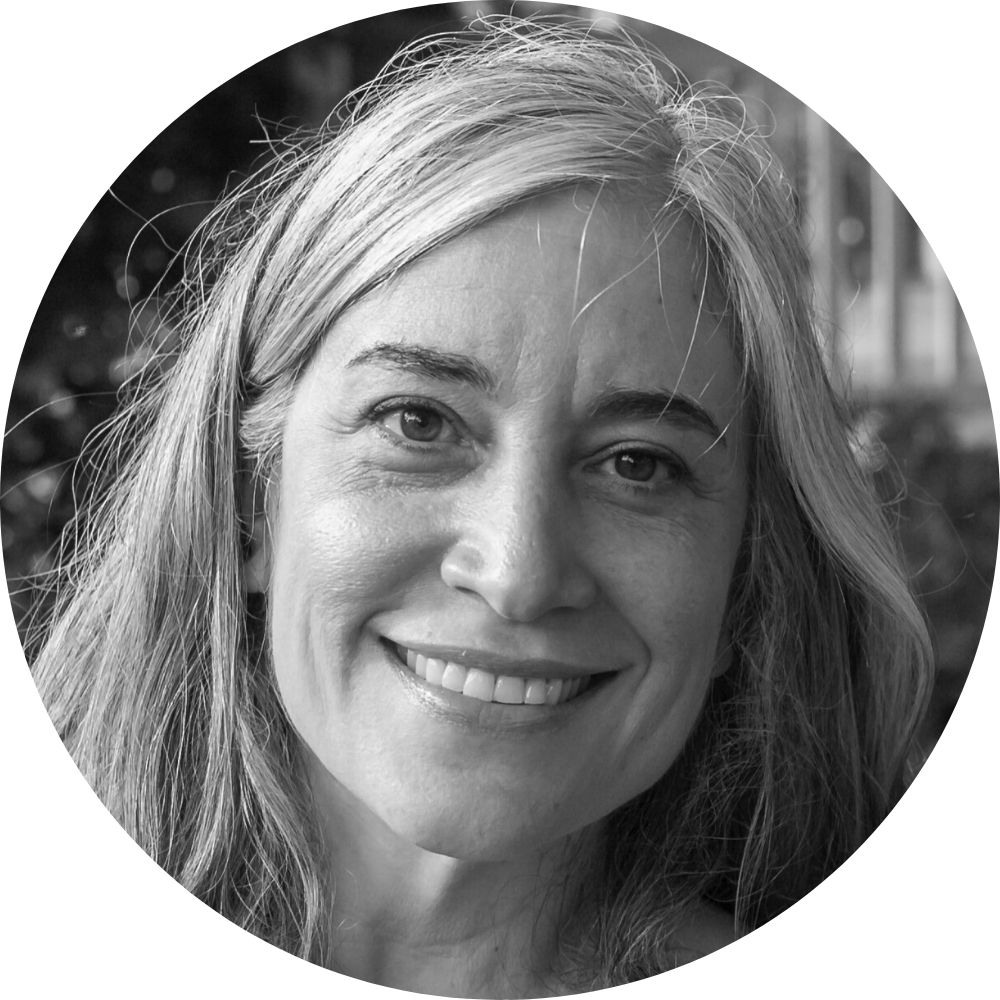
Lori Yeghiayan Friedman
Lori Yeghiayan Friedman was born and raised in Southern California and has an MFA in Theatre from the University of California at San Diego. Her first creative nonfiction piece, Voo Hunting, was published in Post Road Magazine Issue 35.
Featured image: Photograph of Armenia by Hakop Melkonyan on Unsplash.
